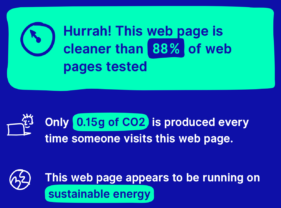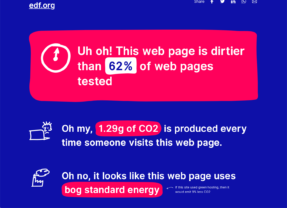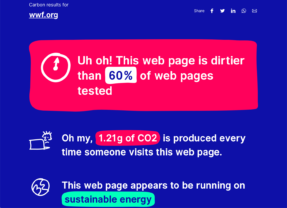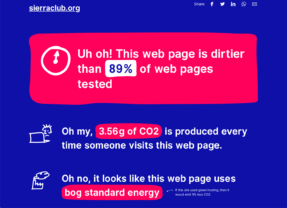Your Question for Earth Week
How much carbon is your organization’s website dumping into our atmosphere each year?
Not a question you’re likely to encounter at the next board meeting. But one we should all ponder – especially during this year’s Earth Week.
Digital is physical and it sure ain’t green. In fact, Digital costs the Earth. Every time you and I do a search, check a webpage, download an email or Tweet we create pollution. That’s because the data centers that deliver all these bits and bytes are massive physical structures filled with energy-hungry computers.
Sure, it’s all invisible and seems cheap and free, but the Earth pays a big price.
Here, according to Gerry McGovern’s World Wide Waste, are some facts that will give you a feel for digital –analyzed by the author in how many trees would need to be planted to offset a particular digital activity.
- 6 billion trees would have to be planted to offset the pollution caused by email spam.
- 5 billion trees would need to be planted to deal with annual e-commerce returns in the U.S. alone.
- 16 million trees would need to be planted to offset the pollution caused by the estimated 1.9 trillion yearly searches on Google.
As Gerry notes, “We don’t have an energy production crisis. We have an energy consumption crisis. We consume far too much of everything the Earth produces and in the last 40 years our appetites for everything have exploded, driven and enabled by advances in digital technology…. We consume too much energy, that’s the problem, and like our waistlines, these habits have gone out of control.
Each of us bears some responsibility. And, when it comes to the waistline of our websites each of us needs to be far more aware than we currently are. Digital designers, webmasters and comms folks have a terror of deleting or removing. The consequence of this never-delete theology is that most of the digital world suffers from a digestive system that has not capacity or inclination to poop.
It doesn’t have to be that way. And shouldn’t be that way. Fortunately, it’s easy to find out how wasteful and inefficient your website is and what you can do to become more energy efficient and less carbon corrupt.
Here are three resources you should put to work immediately for a quick check of your own website and some insight into waste management:
- Global Warming Blog, a marvelous reference for understanding the various ways to determine web page size and problems. With links to additional resources.
- Pingdom calculates both the speed and the carbon emissions from your web pages and offers a prescriptive checklist along with a grading system from A-F on what needs improving.
- Website Carbon Calculator is a great tool to estimate the carbon footprint of a web page. It has kindly been created byWholegrain Digital, a sustainable web design agency from London, UK. The tool is meant ‘to help inspire and educate people to create a zero-carbon internet’.
The tool tells you two things:
- The carbon footprint of the web page as CO2 At the time of writing, the average web page tested produces 1.76 g CO2 per page view. For a website with 10,000 monthly page views, that’s 211 kg CO2 per year.
- Whether your website is hosted on renewable energy
Website Carbon Calculator, an easy-to-use, and quite fun tool to determine just how your site ranks, how efficient it is, whether it’s hosted by a firm using renewable energy or not. It reveals how much carbon you dump into the atmosphere each year; how many trees need to be planted to atone for your sins and lots of other fun facts.
Here’s a quick look at the Carbon Calculator’s take on The Agitator

In addition to those facts, a quick checkup of The Agitator web pages also reveals that its webpage is “cleaner than 63% of webpages tested.” …. that we would use 9% less electricity if we used a green hosting service…that we use enough power to drive an electric care 1,937 miles…and we emit an amount of carbon that 4 trees absorb in a year.
Given that it’s Earth Week we couldn’t resist checking out the websites of a few of our favorite environmental organizations:
GREENPEACE

ENVIRONMENTAL DEFENSE

WWF

SIERRA CLUB

AND…. EARTH DAY.ORG

Clearly, sustainability begins at home.
Roger
P.S. SPRING CLEANING NOTE: On a different, but important, subject. I hope you’ll join Laurence Pagnoni and me for a discussion session titled: STARTING OVER: A Dialogue About Individual Donor Engagement and Stewardship from 11:00 AM-12:00PM Eastern on Wednesday, April 21. Registration is free.
We’ll cover a range of topics with an eye toward what a fresh start with your donors looks like. I hope you’ll join us on Wednesday.



Roger, Great column. Shared widely & will pass on to all our clients.